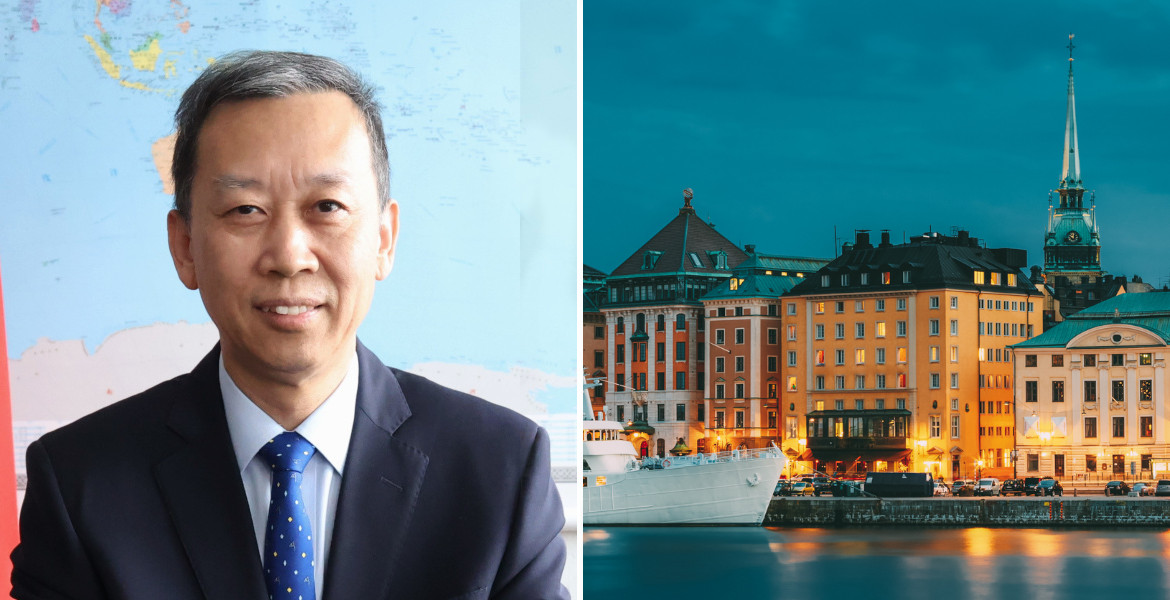Recently I read a story about a Nobel laureate introducing a special map of innovation. Each time after he’s done with his scientific research, he’d show gratitude to all the team members from the laboratory, sometimes not only by announcing their names, but also taking out a world map and pinning their birthplaces on it. He exclaims over the spectacular map, which reflects the geographical diversity of the team members who come from Asia, Europe and the Americas, and they’ve also been trying to include more members from Africa and South America.
This story shows that science knows no borders. Scientific research is increasingly relying on big teams, big data, big devices and big collaboration. Major scientific and technological innovations are never created by one country or individual team alone, but are the result of large-scale international cooperation.
China and Sweden have something in common regarding innovation. China has a tradition of innovation since ancient times. The inscription on the bathtub of ancient King Tang of Shang Dynasty from 1600 BC says 苟日新,日日新,又日新, meaning to pursue new development, new changes and strive to innovate every day. Ancient China gave rise to the world-famous Four Great Inventions, including paper-making, the compass, gunpowder and printing, which have propelled the progress of human civilization.
China and Sweden have something in common regarding innovation.
China has an inexhaustible driving force to pursue scientific and technological progress. In recent decades, China has succeded in innovation by “leapfrogging”, entered the ranks of innovative countries and become an important participant of international cutting-edge innovation and a significant contributor to the solutions of global issues. China ranked 12th on the Global Innovation Index in 2023, climbing more than 20 places in the past decade. China published 24.6% of the global total scientific research papers and the number of valid invention patents in China has reached 4.805 million, both ranking the first in the world.
In quantum information, stem cells, brain-like chips and other frontier directions, China has made a number of major original achievements with international influence. A number of major scientific and technological infrastructure facilities with world-class standards, such as the Five-hundred-meter Aperture Spherical Telescope (FAST) and the China Spallation Neutron Source have been completed and played an important role. Scientific and technological innovation has injected strong vitality into China’s modern industrial system. China’s domestically-developed large passenger aircraft was put into market operation, and a 600kph maglev test vehicle rolled off the assembly line, setting an international benchmark for high-speed rail construction.
Sweden has always attached importance to innovation and respected innovation and is the world’s leading country in scientific and technological innovation, ranking very high on the Global Innovation Index and the EU innovation Scoreboard for years and leading in sustainable development, life sciences, advanced manufacturing and other fields in the world. Swedish inventions have had a profound impact on the world. Zippers, Celsius thermometers, Bluetooth technology, Tetra Pak packaging are facilitating our lives. Gamma Knife, cardiac pacemaker, artificial kidneys and echocardiography are providing treatments to countless patients.
Swedish inventions have had a profound impact on the world.
Sweden was the first country to carry out environmental protection, and also the first to introduce the concept of sustainable development. Fossil-free steel, hydrogen fuel cell trucks, waste recycling and re-usage, renewable energy and other leading environmental products and technologies contribute to the sustainable development process. Large-scale scientific research infrastructure such as the MAX IV Laboratory and the European Spallation Source, which Sweden has participated in, have provided an important platform for groundbreaking and innovative research across fields and borders.
Over the past decade, scientific and technological innovation cooperation between Sweden and China has grown rapidly, and China has become one of Sweden’s most important partners in scientific research. The practical outcomes can be seen in various fields. At the outbreak of covid-19, 50 experts from both countries quickly formed a joint research and treatment team to conduct international multi-center joint research, and the clinical research results were proved effective. Leading institutes of life sciences of the two countries have continued to deepen cooperation in clinical treatment and disease research, and expressed their willingness to jointly address global health challenges and make greater contributions to the development of global health.
Universities and research institutions of the two sides have actively carried out cooperation and personnel exchanges in the fields of natural science, engineering and technology, especially green environmental protection, smart cities and clean energy. In recent years, the number of papers jointly published by the two sides has doubled with the impact factor also higher. A number of joint research and development technologies have been among the world’s leading level. New solar energy storage and power generation system jointly developed by China and Sweden can convert solar energy into electricity with a storage time of up to 18 years. China is one of the key partners of Swedish research funding institutions. The science funds of the two countries have actively deepened policy dialogue and exchanges to jointly promote the research and development of high-quality scientific and technological innovation results.
China is one of the key partners of Swedish research funding institutions.
The cooperation in scientific and technological industries between the two countries continues to expand and unleash new vitality, making contributions to the global reduction of carbon emission and promoting sustainable development. Atlas Copco, AstraZeneca, Scania trucks, Sandvik and other large Swedish technological manufacturing enterprises have invested in setting up factories and R&D centers in China. A series of investment and cooperation projects have successfully landed in the fields of automobile manufacturing, energy conservation and environmental protection, smart cities etc. Sweden’s leading enterprises in new energy and new materials have accelerated their convergence with Chinese enterprises. A burgeoning round of scientific and technological cooperation in clean energy has taken place. The first Eco City project of China-Sweden Hammarby Eco City Alliance, covering an area of 670,000 square meters, was established in Yantai, which received wide recognition from the market.
Recently, China has released the Global AI Governance Initiative, proposing a people-centered and “AI for Good” approach, upholding the principles of mutual respect, equality, and mutual benefit in AI development, building consensus through dialogue and cooperation, developing open, fair, and efficient governing mechanisms, in a bid to promote AI technologies to benefit humanity. Not long ago, China proposed the International Science and Technology Cooperation Initiative for the first time, calling for advocating and practicing the concept of open, fair, just and non-discriminatory international cooperation in science and technology, adhering to the principle that “science knows no borders and benefits all mankind”, enhancing international cooperation, openness and sharing, and to jointly build a global science and technology community.
Sweden also attaches great importance to international scientific and technological cooperation, continuously enhancing the level of internationalization of scientific research and encouraging researchers to engage in international exchange, responding to global challenges and economic and social development demands with high-level scientific research outcomes. The wish to expand international cooperation in science and technology and the notion to promote the common well-being of the two peoples and all mankind through scientific and technological innovation of China and Sweden coincide with each other.

In my communication with researchers, students, scholars and entrepreneurs from both China and Sweden, I have heard many stories of cooperation, development and friendship. Researchers of the two countries believe that the joint research has complementary advantages and has been pleasant, having raised the level of innovation of the two countries, promoted sustainable economic and social development, and contributed to addressing the common challenges of mankind. In order to thank the Swedish mentors for decades of education and cultivation, Chinese researchers have produced a beautiful commemorative book with photos documenting the efforts of researchers of the two countries to work together to overcome difficulties and jointly develop world-leading technologies.
Partners of scientific and technological enterprises of the two countries said that the two sides are highly complementary in research and development, and the exchange and cooperation would effectively promote the development of industrial technology and enhance the global competitiveness of enterprises. Some Swedish entrepreneurs who have set up factories in China have praised China’s excellent environment for innovation and entrepreneurship and advanced R & D and manufacturing, and are full of confidence in the development of their enterprises in China.
Scientific and technological innovation is an important engine for human development, and international cooperation has become a must to promote it. China is committed to expanding high-level opening-up, promoting international scientific and technological exchanges and cooperation with a more open mind and measures, sharing scientific and technological innovation achievements with other countries, and promoting the building of a community with a shared future for mankind. I hope that more Chinese and Swedish researchers, experts, scholars, businessmen and entrepreneurs will make friends and become partners, promote, participate in and lead the innovation cooperation between the two countries, and jointly develop the rich mine of “innovation”, create more practical results and enhance the common well-being of mankind.
Cui Aimin, China’s Ambassador to Sweden
















